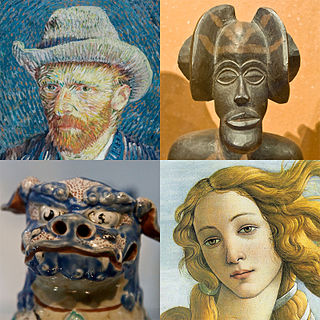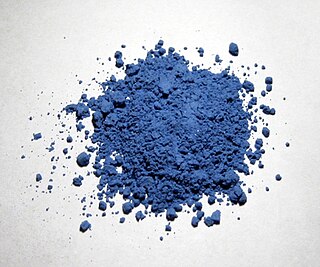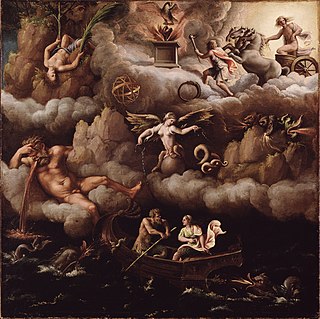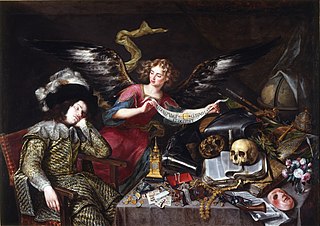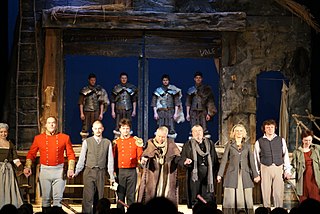
Paint is any pigmented liquid, liquefiable, or mastic composition that, after application to a substrate in a thin layer, converts to a solid film. It is most commonly used to protect, color, or provide texture to objects. Paint can be made or purchased in many colors—and in many different types, such as watercolor, synthetic, etc. Paint is typically stored, sold, and applied as a liquid, but most types dry into a solid.
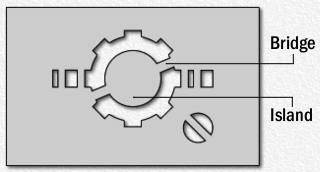
Stencilling produces an image or pattern by applying pigment to a surface over an intermediate object with designed gaps in it which create the pattern or image by only allowing the pigment to reach some parts of the surface. The stencil is both the resulting image or pattern and the intermediate object; the context in which stencil is used makes clear which meaning is intended. In practice, the (object) stencil is usually a thin sheet of material, such as paper, plastic, wood or metal, with letters or a design cut from it, used to produce the letters or design on an underlying surface by applying pigment through the cut-out holes in the material.

Rangoli is an art form, originating in the Indian subcontinent, in which patterns are created on the floor or the ground using materials such as colored rice, dry flour, colored sand or flower petals. It is usually made during Diwali or Tihar, Onam, Pongal and other Hindu festivals in the Indian subcontinent. Designs are passed from one generation to the next, keeping both the art form and the tradition alive.

Oil paint is a type of slow-drying paint that consists of particles of pigment suspended in a drying oil, commonly linseed oil. The viscosity of the paint may be modified by the addition of a solvent such as turpentine or white spirit, and varnish may be added to increase the glossiness of the dried oil paint film. Oil paints have been used in Europe since the 12th century for simple decoration, but were not widely adopted as an artistic medium until the early 15th century. Common modern applications of oil paint are in finishing and protection of wood in buildings and exposed metal structures such as ships and bridges. Its hard-wearing properties and luminous colors make it desirable for both interior and exterior use on wood and metal. Due to its slow-drying properties, it has recently been used in paint-on-glass animation. Thickness of coat has considerable bearing on time required for drying: thin coats of oil paint dry relatively quickly.

The Gwion Gwion paintings, Bradshaw rock paintings, Bradshaw rock art, Bradshaw figures or The Bradshaws, are terms used to describe one of the two major regional traditions of rock art found in the north-west Kimberley region of Western Australia. The identity of who painted these figures and the age of the art are contended within archaeology and amongst Australian rock art researchers. These aspects have been debated since the works were first discovered and recorded by pastoralist Joseph Bradshaw in 1891, after whom they were named. As the Kimberley is home to various Aboriginal language groups, the rock art is referred to and known by many different Aboriginal names, the most common of which are Gwion Gwion or Giro Giro. The art consists primarily of human figures ornamented with accessories such as bags, tassels and headdresses.
Portable art refers to the small examples of Prehistoric art that could be carried from place to place, which is especially characteristic of the Art of the Upper Palaeolithic. It is one of the two main categories of Prehistoric art, the other being the immobile Parietal art, effectively synonymous with rock art.

Body painting is a form of body art where artwork is painted directly onto the human skin. Unlike tattoos and other forms of body art, body painting is temporary, lasting several hours or sometimes up to a few weeks. Body painting that is limited to the face is known as "face painting". Body painting is also referred to as "temporary tattoo". Large scale or full-body painting is more commonly referred to as body painting, while smaller or more detailed work can sometimes be referred to as temporary tattoos.

A thangka, variously spelt as thangka, tangka, thanka, or tanka, is a Tibetan Buddhist painting on cotton, silk appliqué, usually depicting a Buddhist deity, scene, or mandala. Thangkas are traditionally kept unframed and rolled up when not on display, mounted on a textile backing somewhat in the style of Chinese scroll paintings, with a further silk cover on the front. So treated, thangkas can last a long time, but because of their delicate nature, they have to be kept in dry places where moisture will not affect the quality of the silk. Most thangkas are relatively small, comparable in size to a Western half-length portrait, but some are extremely large, several metres in each dimension; these were designed to be displayed, typically for very brief periods on a monastery wall, as part of religious festivals. Most thangkas were intended for personal meditation or instruction of monastic students. They often have elaborate compositions including many very small figures. A central deity is often surrounded by other identified figures in a symmetrical composition. Narrative scenes are less common, but do appear.

Verdigris is the common name for a green pigment obtained through the application of acetic acid to copper plates or the natural patina formed when copper, brass or bronze is weathered and exposed to air or seawater over time. It is usually a basic copper carbonate, but near the sea will be a basic copper chloride. If acetic acid is present at the time of weathering, it may consist of copper(II) acetate.

A panel painting is a painting made on a flat panel made of wood, either a single piece, or a number of pieces joined together. Until canvas became the more popular support medium in the 16th century, it was the normal form of support for a painting not on a wall (fresco) or vellum, which was used for miniatures in illuminated manuscripts and paintings for the framing.

Bark painting is an Australian Aboriginal art form, involving painting on the interior of a strip of tree bark. This is a continuing form of artistic expression in Arnhem Land and other regions in the Top End of Australia including parts of the Kimberley region of Western Australia. Traditionally, bark paintings were produced for instructional and ceremonial purposes and were transient objects. Today, they are keenly sought after by collectors and public arts institutions.
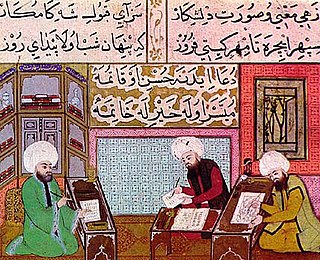
Ottoman miniature or Turkish miniature was an art form in the Ottoman Empire, which can be linked to the Persian miniature tradition, as well as strong Chinese artistic influences. It was a part of the Ottoman book arts, together with illumination (tezhip), calligraphy (hat), marbling paper (ebru), and bookbinding (cilt). The words taswir or nakish were used to define the art of miniature painting in Ottoman Turkish. The studios the artists worked in were called Nakkashanes.

The Doni Tondo or Doni Madonna, is the only finished panel painting by the mature Michelangelo to survive. Now in the Uffizi in Florence, Italy, and still in its original frame, the Doni Tondo was probably commissioned by Agnolo Doni to commemorate his marriage to Maddalena Strozzi, the daughter of a powerful Tuscan family. The painting is in the form of a tondo, meaning in Italian, 'round', a shape which is frequently associated during the Renaissance with domestic ideas.

In the 18th century the Ndzundza Ndebele people of South Africa created their own tradition and style of house painting. Until the late 1900s, the Ndebele people were very fierce warriors and large landowners. In the autumn of 1883, they went to war with the neighboring Boer workers. The loss of the war brought on a harsh life and horrible punishments for the Ndebele. Through those hard times expressive symbols were generated by the suffering people expressing their grief. These symbols were the beginning of the African art known as Ndebele house paintings.

Oceanic art or Oceanian art comprises the creative works made by the native people of the Pacific Islands and Australia, including areas as far apart as Hawaii and Easter Island. Specifically it comprises the works of the two groups of people who settled the area, though during two different periods. They would in time however, come to interact and together reach even more remote islands. The area is often broken down into four separate regions: Polynesia, Micronesia, Australasia, and Melanesia. The former two share a common ancestral culture of the Lapita, while the latter two comprise settlers of the first wave of people into the area. All of the regions in later times would be greatly affected by western influence and colonization. In more recent times, the people of Oceania have found a greater appreciation of their region's artistic heritage.
Australian Aboriginal culture includes a number of practices and ceremonies centered on a belief in the Dreamtime. Reverence for the land and oral traditions are emphasized. Language groupings and tribal divisions exhibit a range of individual cultures. Australian Aboriginal art has existed for thousands of years and ranges from ancient rock art to modern watercolor landscapes. Aboriginal music has developed a number of unique instruments. Contemporary Australian aboriginal music is predominantly of the country music genres. Indigenous Australians did not develop a system of writing.
Preserving parchment becomes more difficult when pigments, inks, and illumination are added into the equation. Pigments do not dye parchment; instead, they lie on the surface of the parchment and so are rather fragile. The goal of restoring illuminated manuscripts should be to make them resilient to damage while altering them as little as possible. Each individual manuscript, and even each individual page, must be considered as a separate object with different aspects that must be taken into consideration. This in turn will help determine the best course of preservation or conservation treatment.
In Australian Aboriginal art, a Dreaming is a totemistic design or artwork, which can be owned by a tribal group or individual. This usage of Stanner's term was popularised by Geoffrey Bardon in the context of the Papunya Tula artist collective he established in the 1970s.

Painting is the practice of applying paint, pigment, color or other medium to a solid surface. The medium is commonly applied to the base with a brush, but other implements, such as knives, sponges, and airbrushes, can be used. The final work is also called a painting.

Litema is a form of Sesotho mural art composed of decorative and symbolic geometric patterns, commonly associated with Sesotho tradition today practised in Lesotho and neighbouring areas of South Africa. Basotho women generate litema on the outer walls and inside of homesteads by means of engraving, painting, relief mouldings and/or mosaic. Typically the geometric patterns are combed or scratched into the wet top layer of fresh clay and dung plaster of the wall, and later painted with earth ochers or, in contemporary times, manufactured paint. Patterns most often mimic ploughed fields through a combed texture, or the patterns refer to plant life, and more occasionally to other aspects of the natural world, such as referring to clan totem animal. Litema are transient; they may desiccate and crumble or be washed away by heavy rain. It is common for women of an entire village to apply litema on such special occasions as a wedding or a religious ceremony.
